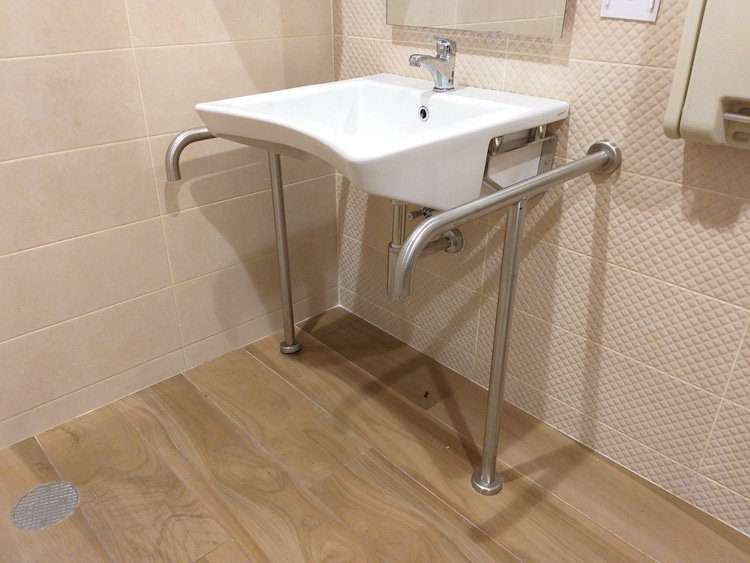If you or a loved one has mobility challenges, a well-designed disability bathroom can make daily routines safer and more dignified. From brushing teeth to washing hands, a thoughtfully selected sink can help maintain independence and reduce physical strain.
Whether you’re caring for an elderly family member, a wheelchair user, or someone with limited mobility, accessible bathroom basins can play a key role in ensuring ease of use and safety.
As one of the UK’s leading experts in accessible bathrooms, we’ve helped thousands of people regain control and comfort with walk-in showers, mobility toilets, and disabled-friendly sinks. This guide covers the top 5 types of disabled sinks and the essential features to look for when designing or upgrading a disability bathroom.
Key Features to Look for in Disabled Sinks
When choosing a sink for an accessible or disability bathroom, consider features that prioritise functionality, safety, and ease of use.
Accessibility is key, so choose basins designed with enough clearance underneath to comfortably accommodate wheelchair users.
- Ensure ample space beneath the basin for wheelchair users, perhaps using built-in storage space like reachable drawers.
- Wall-mounted designs are ideal for functionality and a modern aesthetic.
Height is another important factor. It’s important to install fixed-height sinks at an appropriate height to ensure they are easy to use and accessible.
- Consider height-adjustable sinks for households with multiple users.
- Install fixed-height sinks at an accessible height for ease of use.
Ergonomics increases both usability and is safer for vulnerable people. Sinks with shallow basins and rounded edges minimise risk and are easier to use for individuals with limited mobility.
- Opt for shallow basins and smooth, rounded edges for safety and convenience.
- Choose accessible tap controls, such as lever handles or touchless sensors, to reduce strain.
Materials add to durability and general maintenance. Opt for materials designed to withstand daily use while simplifying cleaning and maintaining a hygienic space.
- Use sturdy, non-porous materials like ceramic or stainless steel for durability and hygiene.
- Ensure secure fittings, particularly for wall-mounted designs, to support additional pressure.
By keeping these features in mind, you can ensure that your sink choice provides functionality and comfort, tailored to the specific needs of the user. It’s been recorded that in the UK one in three people over 65 have a fall at least once a year. Ensuring that the bathroom has adequate support and proper equipment can drastically reduce the risk of injury.

The 5 Best Types of Disabled Sinks
Let’s take a closer look at the most effective and user-friendly sink designs for disability bathrooms:
1. Adjustable Height Sinks
Adjustable sinks can be raised or lowered manually or electronically to suit individual users. They’re ideal for shared bathrooms where family members or carers with different mobility levels need flexibility.
Benefits:
– Suitable for multiple users
– Improves comfort and posture
– Supports independent use
2. Low-Height Disabled Sinks
Designed for wheelchair access, these fixed-height sinks typically measure between 85cm and 95cm from floor to rim. They offer ample space underneath for leg clearance and ease of movement.
Benefits:
– Optimised for seated use
– Fixed height reduces complexity
– Compliant with UK accessibility standards
3. Grab Bar Assisted Sinks
These sinks come with integrated grab rails or are installed near support rails. They offer balance support for elderly users or those with reduced strength, making sink use safer and more stable.
Benefits:
– Provides added safety and balance
– Boosts confidence for independent use
– Ideal for fall prevention
4. Curved Disabled Sinks
Curved or concave basins are designed to let the user get closer to the taps. They’re especially useful for wheelchair users, and the lack of sharp corners improves both safety and aesthetics.
Benefits:
– More ergonomic design
– Easier to reach controls
– Stylish and modern
5. Swing Sinks
Swing or pivoting sinks can rotate to the side or away from the user to save space. These are great for compact bathrooms and provide flexible access without sacrificing functionality.
Benefits:
– Customisable positioning
– Excellent for tight spaces
– User-friendly for varied mobility needs
Let Us Help You Choose the Right Disability Sink
We understand the struggle mobility issues, age, and disabilities can bring to every aspect of life. Having dignity and accessibility in your home is crucial. There are now more options than ever to easily refit your home for better support and independence. At Age Care Bathrooms, we offer no-obligation free quotes and can tailor-make your washroom with the latest technology and features.
From simple assistance to entirely new walk-in showers and mobility bathrooms, contact us today and see how we can help.
Download our free brochure or speak directly with a friendly specialist – we’re here to help.
